Weizhi Zhong
High-fidelity and Lip-synced Talking Face Synthesis via Landmark-based Diffusion Model
Aug 10, 2024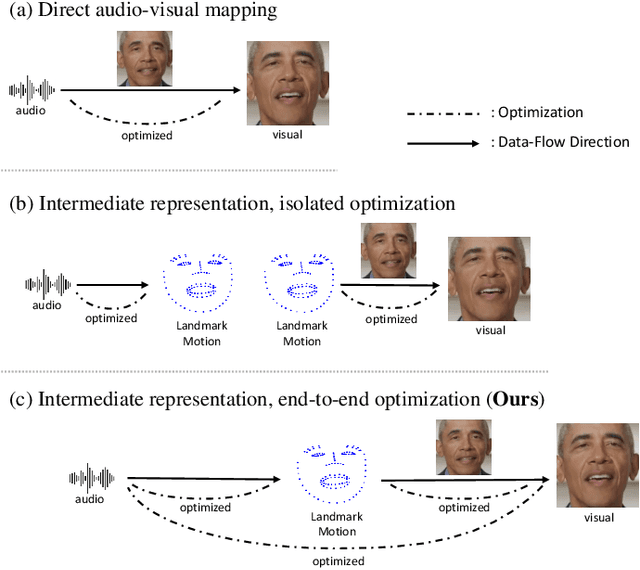
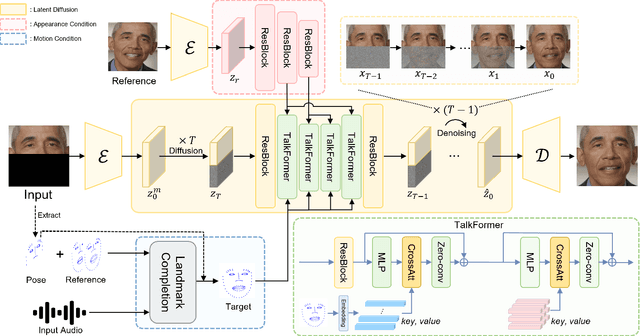
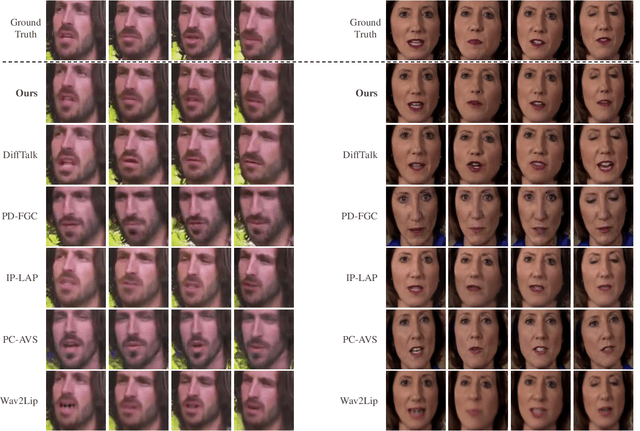
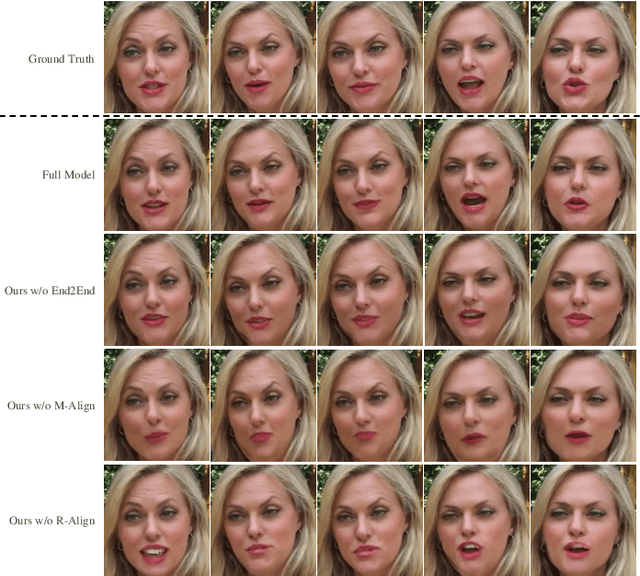
Abstract:Audio-driven talking face video generation has attracted increasing attention due to its huge industrial potential. Some previous methods focus on learning a direct mapping from audio to visual content. Despite progress, they often struggle with the ambiguity of the mapping process, leading to flawed results. An alternative strategy involves facial structural representations (e.g., facial landmarks) as intermediaries. This multi-stage approach better preserves the appearance details but suffers from error accumulation due to the independent optimization of different stages. Moreover, most previous methods rely on generative adversarial networks, prone to training instability and mode collapse. To address these challenges, our study proposes a novel landmark-based diffusion model for talking face generation, which leverages facial landmarks as intermediate representations while enabling end-to-end optimization. Specifically, we first establish the less ambiguous mapping from audio to landmark motion of lip and jaw. Then, we introduce an innovative conditioning module called TalkFormer to align the synthesized motion with the motion represented by landmarks via differentiable cross-attention, which enables end-to-end optimization for improved lip synchronization. Besides, TalkFormer employs implicit feature warping to align the reference image features with the target motion for preserving more appearance details. Extensive experiments demonstrate that our approach can synthesize high-fidelity and lip-synced talking face videos, preserving more subject appearance details from the reference image.
Style-Preserving Lip Sync via Audio-Aware Style Reference
Aug 10, 2024Abstract:Audio-driven lip sync has recently drawn significant attention due to its widespread application in the multimedia domain. Individuals exhibit distinct lip shapes when speaking the same utterance, attributed to the unique speaking styles of individuals, posing a notable challenge for audio-driven lip sync. Earlier methods for such task often bypassed the modeling of personalized speaking styles, resulting in sub-optimal lip sync conforming to the general styles. Recent lip sync techniques attempt to guide the lip sync for arbitrary audio by aggregating information from a style reference video, yet they can not preserve the speaking styles well due to their inaccuracy in style aggregation. This work proposes an innovative audio-aware style reference scheme that effectively leverages the relationships between input audio and reference audio from style reference video to address the style-preserving audio-driven lip sync. Specifically, we first develop an advanced Transformer-based model adept at predicting lip motion corresponding to the input audio, augmented by the style information aggregated through cross-attention layers from style reference video. Afterwards, to better render the lip motion into realistic talking face video, we devise a conditional latent diffusion model, integrating lip motion through modulated convolutional layers and fusing reference facial images via spatial cross-attention layers. Extensive experiments validate the efficacy of the proposed approach in achieving precise lip sync, preserving speaking styles, and generating high-fidelity, realistic talking face videos.
Identity-Preserving Talking Face Generation with Landmark and Appearance Priors
May 15, 2023Abstract:Generating talking face videos from audio attracts lots of research interest. A few person-specific methods can generate vivid videos but require the target speaker's videos for training or fine-tuning. Existing person-generic methods have difficulty in generating realistic and lip-synced videos while preserving identity information. To tackle this problem, we propose a two-stage framework consisting of audio-to-landmark generation and landmark-to-video rendering procedures. First, we devise a novel Transformer-based landmark generator to infer lip and jaw landmarks from the audio. Prior landmark characteristics of the speaker's face are employed to make the generated landmarks coincide with the facial outline of the speaker. Then, a video rendering model is built to translate the generated landmarks into face images. During this stage, prior appearance information is extracted from the lower-half occluded target face and static reference images, which helps generate realistic and identity-preserving visual content. For effectively exploring the prior information of static reference images, we align static reference images with the target face's pose and expression based on motion fields. Moreover, auditory features are reused to guarantee that the generated face images are well synchronized with the audio. Extensive experiments demonstrate that our method can produce more realistic, lip-synced, and identity-preserving videos than existing person-generic talking face generation methods.
Sparse Bayesian Learning-Based 3D Spectrum Environment Map Construction-Sampling Optimization, Scenario-Dependent Dictionary Construction and Sparse Recovery
Feb 25, 2023



Abstract:The spectrum environment map (SEM), which can visualize the information of invisible electromagnetic spectrum, is vital for monitoring, management, and security of spectrum resources in cognitive radio (CR) networks. In view of a limited number of spectrum sensors and constrained sampling time, this paper presents a new three-dimensional (3D) SEM construction scheme based on sparse Bayesian learning (SBL). Firstly, we construct a scenario-dependent channel dictionary matrix by considering the propagation characteristic of the interested scenario. To improve sampling efficiency, a maximum mutual information (MMI)-based optimization algorithm is developed for the layout of sampling sensors. Then, a maximum and minimum distance (MMD) clustering-based SBL algorithm is proposed to recover the spectrum data at the unsampled positions and construct the whole 3D SEM. We finally use the simulation data of the campus scenario to construct the 3D SEMs and compare the proposed method with the state-of-the-art. The recovery performance and the impact of different sparsity on the constructed SEMs are also analyzed. Numerical results show that the proposed scheme can reduce the required spectrum sensor number and has higher accuracy under the low sampling rate.
A Realistic 3D Non-Stationary Channel Model for UAV-to-Vehicle Communications Incorporating Fuselage Posture
Sep 19, 2022
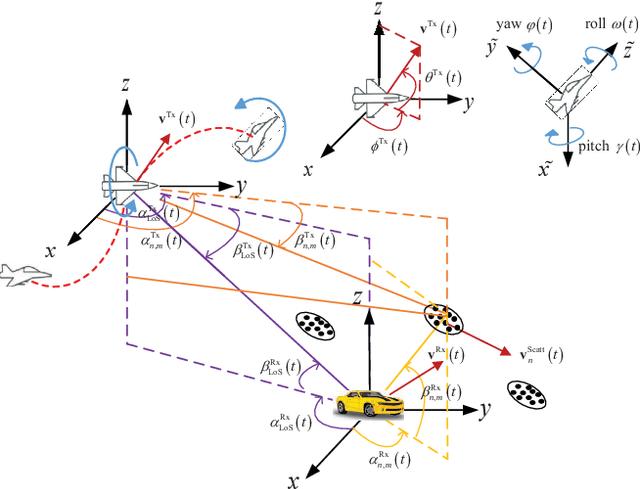
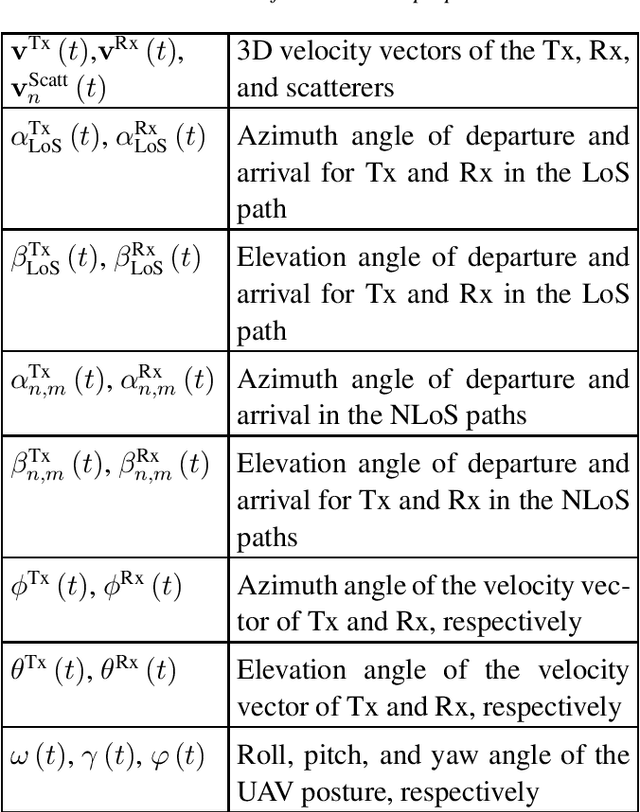
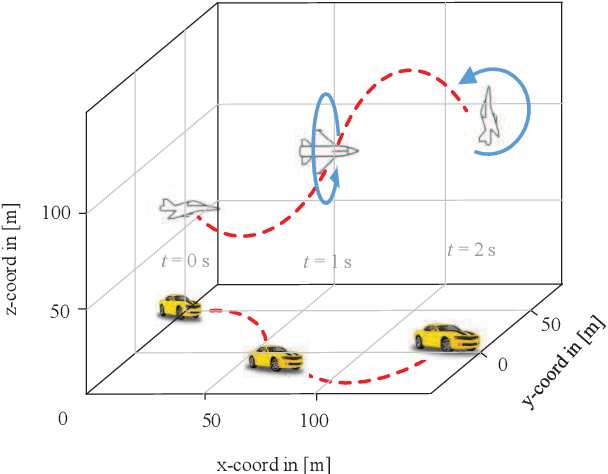
Abstract:Considering the unmanned aerial vehicle (UAV) three-dimensional (3D) posture, a novel 3D non-stationary geometry-based stochastic model (GBSM) is proposed for multiple-input multiple-output (MIMO) UAV-to-vehicle (U2V) channels. It consists of a line-of-sight (LoS) and non-line-of-sight (NLoS) components. The factor of fuselage posture is considered by introducing a time-variant 3D posture matrix. Some important statistical properties, i.e. the temporal autocorrelation function (ACF) and spatial cross correlation function (CCF), are derived and investigated. Simulation results show that the fuselage posture has significant impact on the U2V channel characteristic and aggravate the non-stationarity. The agreements between analytical, simulated, and measured results verify the correctness of proposed model and derivations. Moreover, it is demonstrated that the proposed model is also compatible to the existing GBSM without considering fuselage posture.
Geometry-Based Stochastic Line-of-Sight Probability Model for A2G Channels under Urban Scenarios
Sep 06, 2021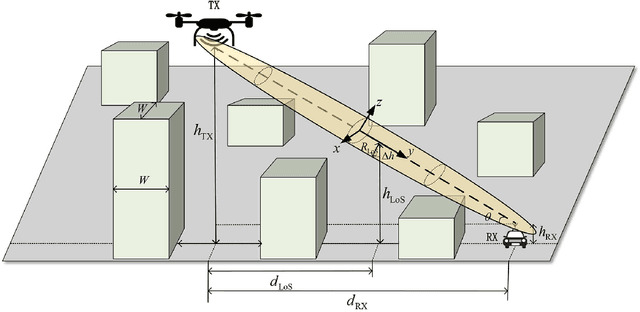
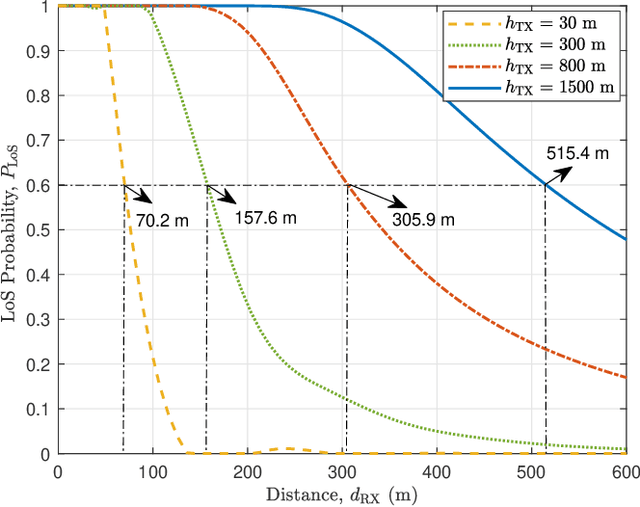
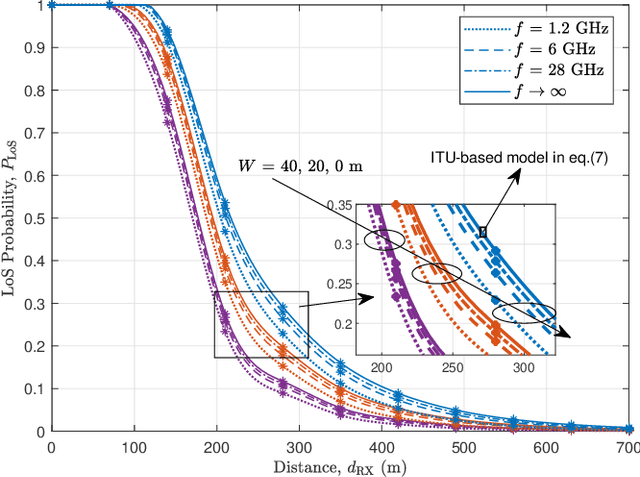
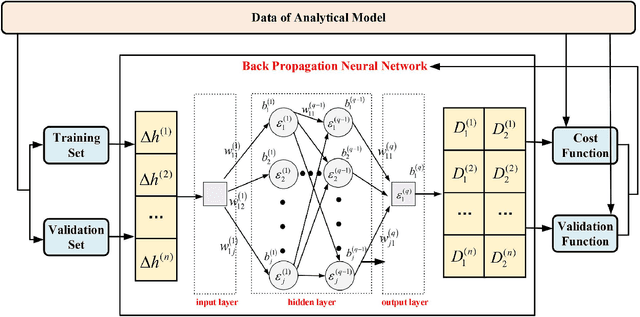
Abstract:Line-of-sight (LoS) path is essential for the reliability of air-to-ground (A2G) communications, but the existence of LoS path is difficult to predict due to random obstacles on the ground. Based on the statistical geographic information and Fresnel clearance zone, a general stochastic LoS probability model for three-dimensional (3D) A2G channels under urban scenarios is developed. By considering the factors, i.e., building height distribution, building width, building space, carrier frequency, and transceiver's heights, the proposed model is suitable for different frequencies and altitudes. Moreover, in order to get a closed-form expression and reduce the computational complexity, an approximate parametric model is also built with the machine-learning (ML) method to estimate model parameters. The simulation results show that the proposed model has good consistency with existing models at the low altitude. When the altitude increases, it has better performance by comparing with that of the ray-tracing Monte-Carlo simulation data. The analytical results of proposed model are helpful for the channel modeling and performance analysis such as cell coverage, outage probability, and bit error rate in A2G communications.
Map-based Channel Modeling and Generation for U2V mmWave Communication
Apr 08, 2021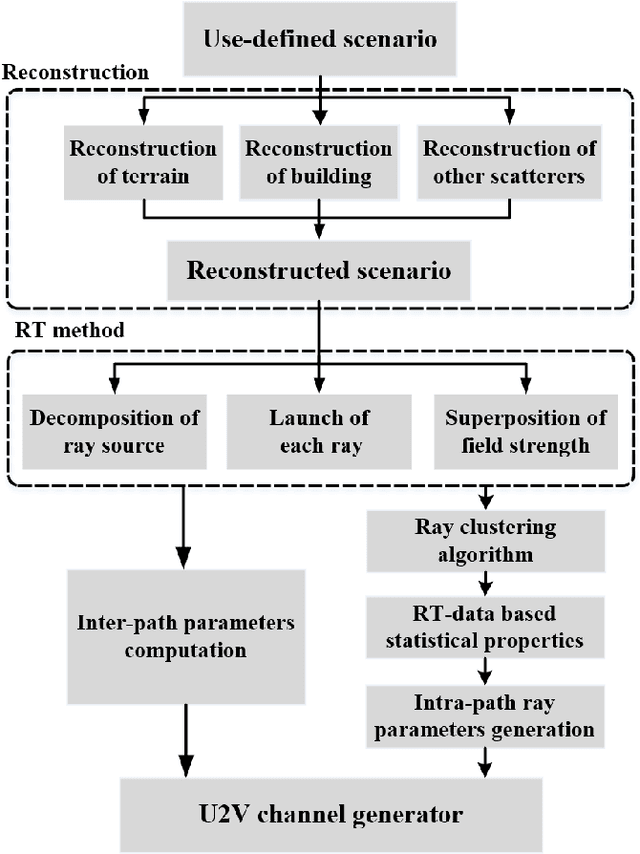
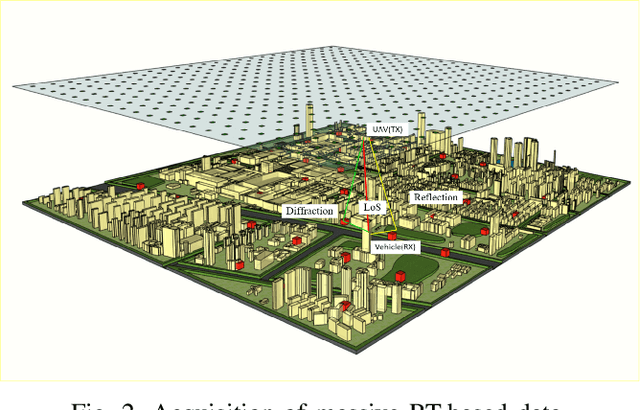
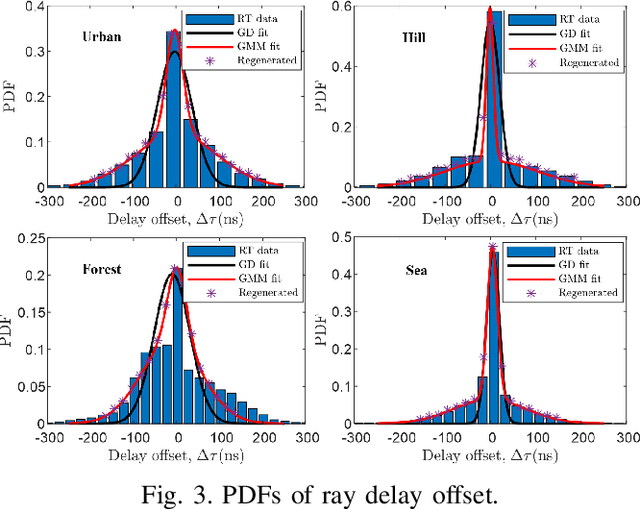
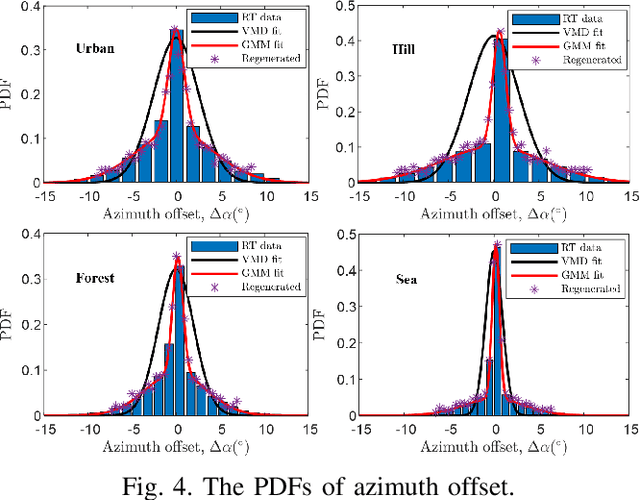
Abstract:Unmanned aerial vehicle (UAV) aided millimeter wave (mmWave) technologies have a promising prospect in the future communication networks. By considering the factors of three-dimensional (3D) scattering space, 3D trajectory, and 3D antenna array, a non-stationary channel model for UAV-to-vehicle (U2V) mmWave communications is proposed. The computation and generation methods of channel parameters including interpath and intra-path are analyzed in detail. The inter-path parameters are calculated in a deterministic way, while the parameters of intra-path rays are generated in a stochastic way. The statistical properties are obtained by using a Gaussian mixture model (GMM) on the massive ray tracing (RT) data. Then, a modified method of equal areas (MMEA) is developed to generate the random intra-path variables. Meanwhile, to reduce the complexity of RT method, the 3D propagation space is reconstructed based on the user-defined digital map. The simulated and analyzed results show that the proposed model and generation method can reproduce non-stationary U2V channels in accord with U2V scenarios. The generated statistical properties are consistent with the theoretical and measured ones as well.
 Add to Chrome
Add to Chrome Add to Firefox
Add to Firefox Add to Edge
Add to Edge